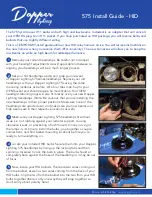
7
EMISSION CONTROL SYSTEMS
2
EMISSION CONTROL
SYSTEMS
H010B01A-AAT
1. Crankcase Emission Control System
The positive crankcase ventilation system is
employed to prevent air pollution caused by
blow-by gases being emitted from the crank-
case. This system supplies fresh filtered air to
the crankcase through the air intake hose.
Inside the crankcase, the fresh air mixes with
blow-by gases, which then pass through the
PCV valve into the induction system.
Canister
Fuel vapors generated inside the fuel tank are
absorbed and stored in the onboard canister.
When the engine is running, the fuel vapors
absorbed in the canister are drawn into the
surge tank through the purge control solenoid
valve.
Purge Control Solenoid Valve (PCSV)
The purge control solenoid valve is controlled
by the Engine Control Module (ECM); when the
engine coolant temperature is low during idling,
the PCSV closes so that evaporated fuel is not
taken into the engine. After the engine warms-
up during ordinary driving, the PCSV opens to
introduce evaporated fuel to the engine.
H010D01A-AAT
3. Exhaust Emission Control
System
The Exhaust Emission Control System is a
highly effective system which controls exhaust
emissions while maintaining good vehicle per-
formance.
H010A01NF-AAT
Your Hyundai is equipped with an emission
control system to meet all emission regulations.
There are three emission control systems which
are as follows.
(1) Crankcase emission control system
(2) Evaporative emission control system
(3) Exhaust emission control system
In order to assure the proper function of the
emission control systems, it is recommended
that you have your car inspected and main-
tained by an authorized Hyundai dealer in ac-
cordance with the maintenance schedule in this
manual.
Caution for the Inspection and Maintenance
Test (With Electronic Stability Control (ESC)
system)
o To prevent the vehicle from misfiring
during dynamometer testing, turn the
Electronic Stability Control (ESC) sys-
tem off by pressing the ESC switch.
o After dynamometer testing is completed,
turn the ESC system back on by pressing
the ESC switch again.
H010C01S-AAT
2. Evaporative Emission Control (Includ-
ing ORVR: Onboard Refueling Vapor
Recovery) System
The Evaporative Emission Control System is
designed to prevent fuel vapors from escaping
into the atmosphere.
(The ORVR system is designed to allow the
vapors from the fuel tank to be loaded into a
canister while refueling at the gas station, pre-
venting the escape of fuel vapors into the
atmosphere.)
Содержание 2008 Sonata
Страница 1: ......
Страница 10: ...F8 INSTRUMENTSANDCONTROLS I B250A01NF AAT B250A01NF A ...
Страница 12: ...F10 INSTRUMENTSANDCONTROLS II B250B01NF AAT B250A02NF A ...
Страница 64: ...1FEATURESOFYOURHYUNDAI 50 INSTRUMENT CLUSTER AND INDICATOR LIGHTS B260A02NF AAT B260B01NF U ...
Страница 249: ...6 DO IT YOURSELFMAINTENANCE 38 G200E01NF AAT Inner Panel HNF4003 ...
Страница 252: ...7 Emission Control System 7 2 Catalytic Converter 7 3 EMISSION CONTROL SYSTEMS 7 ...
Страница 272: ...9 Measurement 9 2 Engine 9 3 Lubrication Chart 9 4 VEHICLE SPECIFICATIONS 9 ...
Страница 276: ...10 INDEX 10 ...
Страница 283: ......
















































